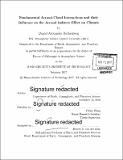| dc.contributor.advisor | Chien Wang. | en_US |
| dc.contributor.author | Rothenberg, Daniel (Daniel Alexander) | en_US |
| dc.contributor.other | Massachusetts Institute of Technology. Department of Earth, Atmospheric, and Planetary Sciences. | en_US |
| dc.date.accessioned | 2017-05-11T19:58:06Z | |
| dc.date.available | 2017-05-11T19:58:06Z | |
| dc.date.copyright | 2017 | en_US |
| dc.date.issued | 2017 | en_US |
| dc.identifier.uri | http://hdl.handle.net/1721.1/108963 | |
| dc.description | Thesis: Ph. D. in Atmospheric Science, Massachusetts Institute of Technology, Department of Earth, Atmospheric, and Planetary Sciences, 2017. | en_US |
| dc.description | Cataloged from PDF version of thesis. | en_US |
| dc.description | Includes bibliographical references (pages 173-189). | en_US |
| dc.description.abstract | The influence of anthropogenic aerosol emissions on the optical properties of clouds and the radiative forcing arising from these interactions, known as the aerosol indirect effect on climate, constitutes a fundamental uncertainty in our understanding of 2 0 th century climate change. In this dissertation, we investigate the role of a keystone physical process, droplet activation, in contributing to this uncertainty. The first half of the ensuing work focuses on the parameterization of this process in global model, assessing both existing schemes and developing a novel one. The second half then quantifies the influence of activation by using a suite of aerosol-climate models which include a complete description of the physics which give rise to the indirect effect. Parameterizations of droplet activation perform well for idealized single-mode aerosol populations, but show systematic biases in high-pollution, weak-updraft regimes. These are exacerbated when the aerosol in question is a complex mixture. We show that estimates of droplet nucleation are highly sensitive to changes in the accumulation mode size and number concentration; this mode is itself sensitive to anthropogenic aerosol emissions, which potentially further biases modeled cloud droplet number. Using a model emulation technique, we develop a framework for building efficient metamodels of activation, which greatly reduce the mean error in droplet number predicted across regimes. The biases in these parameterizations raise questions the influence of activation on the indirect effect. Using different schemes, we calculate a spread of 1 W m- 2 in the indirect effect, which we show is equal to the spread computed from an independent suite of global models with different aerosol and physics modules. The estimated indirect effect scales more strongly with the baseline cloud droplet number concentration simulated by each model than by its change from pre-industrial to present day, indicating a strong saturation effect. While present-day estimates of aerosol-cloud interactions derived from satellite-based instruments are inadequate at constraining the pre-industrial cloud droplet burden, we show that process-based measurements could overcome this problem. | en_US |
| dc.description.statementofresponsibility | by Daniel Alexander Rothenberg. | en_US |
| dc.format.extent | 189 pages | en_US |
| dc.language.iso | eng | en_US |
| dc.publisher | Massachusetts Institute of Technology | en_US |
| dc.rights | MIT theses are protected by copyright. They may be viewed, downloaded, or printed from this source but further reproduction or distribution in any format is prohibited without written permission. | en_US |
| dc.rights.uri | http://dspace.mit.edu/handle/1721.1/7582 | en_US |
| dc.subject | Earth, Atmospheric, and Planetary Sciences. | en_US |
| dc.title | Fundamental aerosol-cloud interactions and their influence on the aerosol indirect effect on climate | en_US |
| dc.type | Thesis | en_US |
| dc.description.degree | Ph. D. in Atmospheric Science | en_US |
| dc.contributor.department | Massachusetts Institute of Technology. Department of Earth, Atmospheric, and Planetary Sciences | |
| dc.identifier.oclc | 986489634 | en_US |
